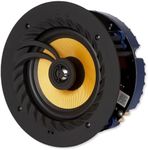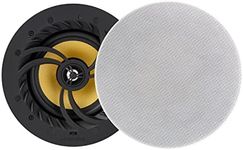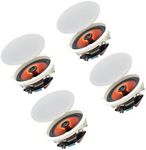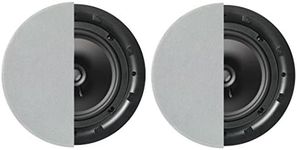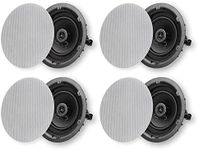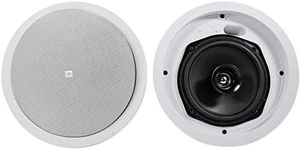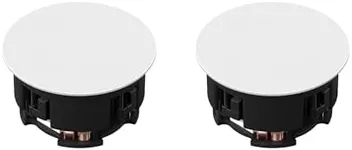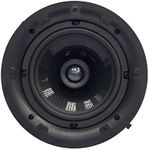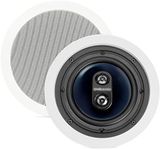Buying Guide for the Best In Ceiling Speakers
In-ceiling speakers are a great choice for those looking to save space and achieve a clean, minimalist look while still enjoying high-quality audio. They are installed directly into the ceiling, making them ideal for home theaters, multi-room audio systems, or even commercial spaces. When choosing in-ceiling speakers, it's important to consider several key specifications to ensure you get the best sound quality and performance for your specific needs. Understanding these specifications will help you make an informed decision and find the perfect speakers for your space.Speaker SizeSpeaker size refers to the diameter of the speaker cone, typically measured in inches. This is important because it affects the speaker's ability to produce sound, particularly in terms of bass response. Larger speakers (8 inches or more) generally produce deeper bass and are suitable for larger rooms or home theater setups. Medium-sized speakers (6.5 inches) offer a balance between bass and clarity, making them versatile for various room sizes. Smaller speakers (5.25 inches or less) are ideal for smaller spaces or for use as part of a multi-speaker setup. Consider the size of your room and the type of audio experience you desire when selecting the speaker size.
Power HandlingPower handling indicates the amount of power a speaker can handle from an amplifier without being damaged, usually measured in watts. This is crucial for ensuring that your speakers can handle the output from your audio system. Speakers with higher power handling (100 watts or more) are suitable for larger rooms or louder listening environments. Medium power handling (50-100 watts) is adequate for most home applications. Lower power handling (below 50 watts) is suitable for smaller rooms or background music. Match the power handling of the speakers with the output of your amplifier for optimal performance.
Frequency ResponseFrequency response refers to the range of sound frequencies a speaker can reproduce, measured in hertz (Hz). This is important for understanding the speaker's ability to deliver a full range of sound, from deep bass to high treble. A wider frequency response (e.g., 40Hz-20kHz) indicates a speaker can reproduce a broader range of sounds, which is ideal for a more immersive audio experience. A narrower frequency response may be sufficient for background music or less critical listening. Consider the type of audio content you will be playing and your personal preference for sound quality when evaluating frequency response.
SensitivitySensitivity measures how efficiently a speaker converts power into sound, expressed in decibels (dB). This is important because it affects how loud the speaker will be at a given power level. Higher sensitivity (90 dB or more) means the speaker can produce more sound with less power, making it suitable for larger rooms or systems with lower-powered amplifiers. Medium sensitivity (85-89 dB) is common and works well in most home environments. Lower sensitivity (below 85 dB) may require more power to achieve the same volume, which could be a consideration for smaller rooms or quieter listening. Choose a sensitivity level that matches your room size and listening habits.
Installation FeaturesInstallation features refer to the design aspects that make it easier to install the speakers in your ceiling. This is important for ensuring a smooth and secure installation process. Look for features like a paintable grille, which allows the speaker to blend seamlessly with your ceiling, or a dog-leg mounting system, which simplifies the installation process. Some speakers also offer moisture-resistant materials, making them suitable for use in bathrooms or kitchens. Consider your DIY skills and the specific location where you plan to install the speakers when evaluating installation features.
